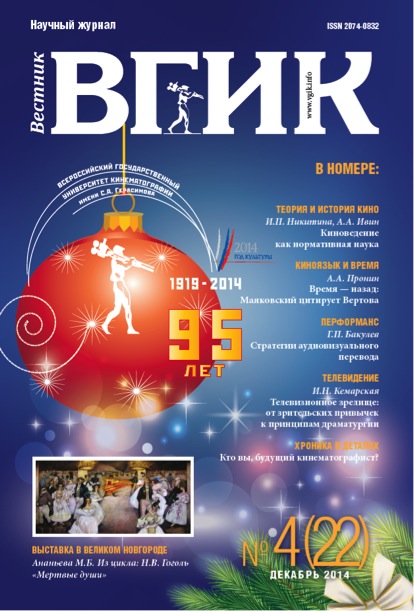Video Art: “A White Cube” or “A Black Box”?
- Authors: Staruseva-Persheeva A.D.1
-
Affiliations:
- VGIK
- Issue: Vol 6, No 4 (2014)
- Pages: 114-123
- Section: SCIENCE LABORATORY | YOUNG SCIENTISTS’ RESEARCH
- URL: https://journals.eco-vector.com/2074-0832/article/view/14814
- DOI: https://doi.org/10.17816/VGIK64114-123
- ID: 14814
Cite item
Full Text
Abstract
Video art is a hybrid, combining features of both contemporary art as well as screen arts. It brings together different ways of perception working both in a manner of a movie which transfers the viewer into virtual daydreaming (Matthew Barney, Steeve McQueen), and in a manner of a painting or sculpture which gives a viewer some intense corporal experience (Tony Oursler). Accordingly, there are two ways of presenting video art: in “a white cube” and “a black box”. In 1970-s video art used to be presented in “white cubes” of contemporary art galleries where they nailed the screens right to the wall. In “a white cube” video comes into the viewer’s sight together with other items in display, therefore a show-piece comes into contact with other ones in a spectator’s mind’s eye. Moreover, “a white cube” gives visitors an opportunity to be in charge of their time of viewing, which implies, that the “white cube” perception appears rather chaotic and the “final cut” of a video in the spectator’s mind becomes unpredictable, what is characteristic of video. In 2000-s when both video and film technologies got replaced by the digital one, all the moving pictures started to resemble one another. A well-lit room of “a white cube” was not appropriate for high definition videos, whereas “a black box” is usually associated with a cinema hall and consequently a video presented in such a “cinematic” manner makes a viewer unconsciously expect to see a “cinematic” piece of art. Video today is an indispensable figurant of any significant exhibition of contemporary art and it is defined as an artistic (not cinematic) media. Traditionally video is being exhibited in “a white cube” of a gallery; however, there is now a distinct tendency to present video art in “a black box”, that is in a “cinematic” way. As a result it’s getting harder and harder to distinguish video art from experimental cinema. Nowadays the very strategy of presentation of video may help this media to retain identity or to lose it.
About the authors
Alexandra Dmitrievna Staruseva-Persheeva
VGIK
Author for correspondence.
Email: editor@vestnik-vgik.com
post-graduate student (Cinema Studies Department)
References
- Косенкова Н.Г. Влияние новейших аудиовизуальных технологий на восприятие зрителя// Вестник ВГИК. - 2011. - № 7. - С. 80-88
- Уразова С.Л. О противостоянии медиумов и новых формах экранного продукта // Вестник ВГИК. - 2013. - № 4 (18). - С. 138-144.
- Campany D. The cinematic: documents of contemporary art. - London: The MIT Press, Cambridge, Massachusetts, 2007.
- Christian Metz. The Imaginary Signifier: Psychoanalysis and the Cinema. - London and Basingstoke: Macmillan, 1982; and Bloomington: Indiana University Press, 1982.
- Grau О. Virtual Art: From Illusion to Immersion. - MIT Press/Leonardo Books, 2003.
Supplementary files








